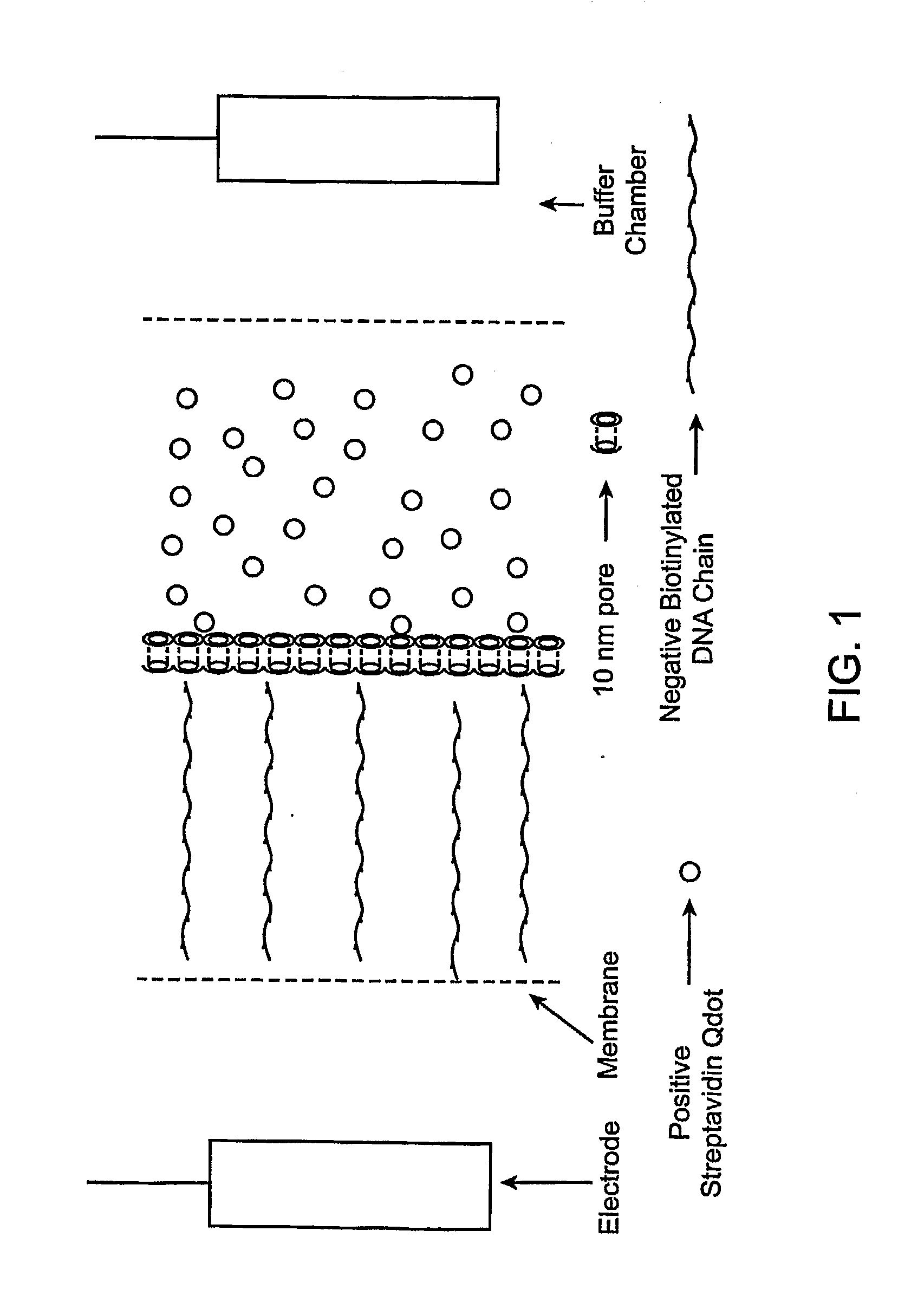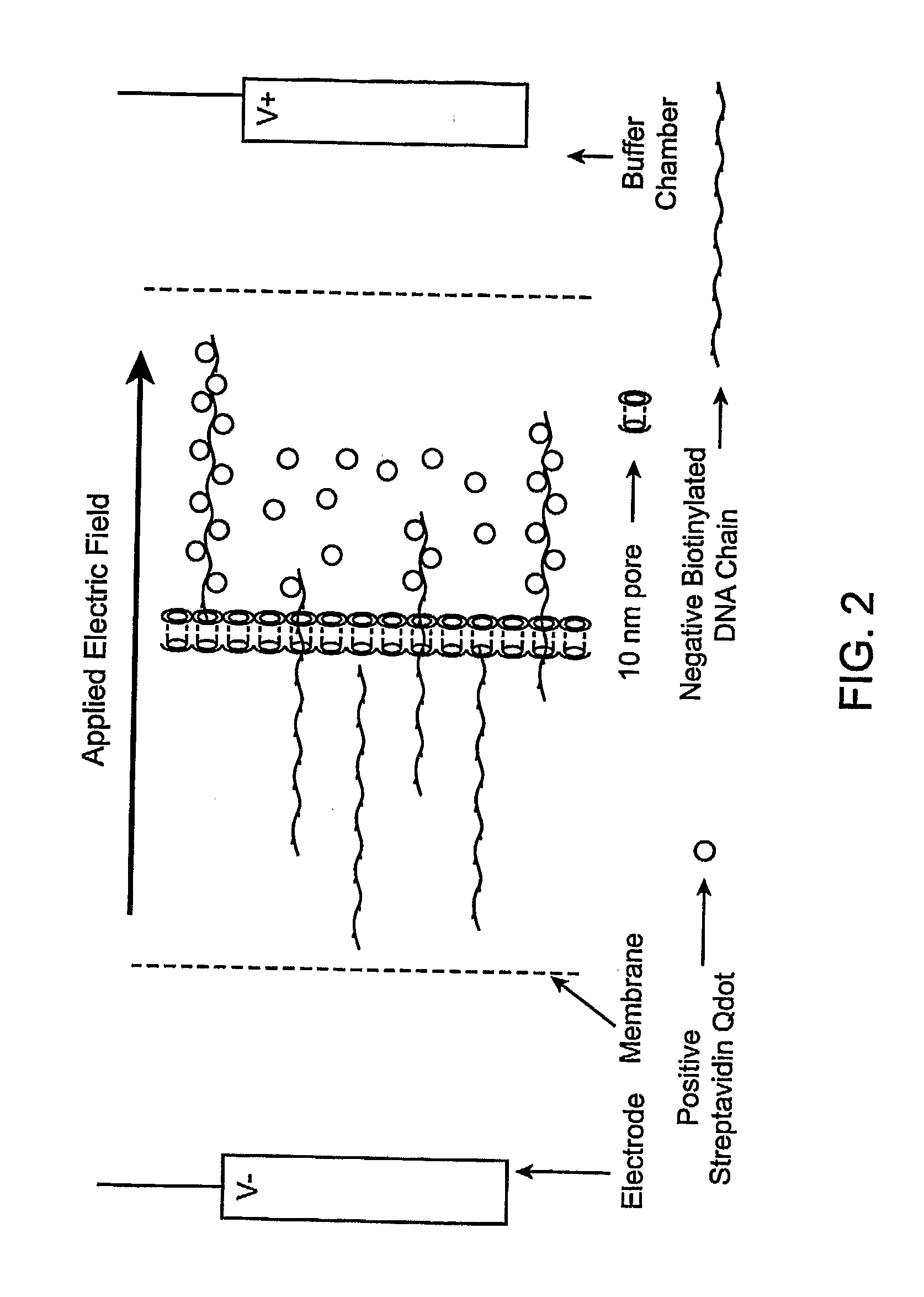Nanofabrication processes and devices for the controlled assembly of functionalized nanostructures
a functionalized nanostructure and nanofabrication technology, applied in the direction of nucleotide libraries, instruments, library creation, etc., can solve the problems of crosslinking into useless aggregates, difficult to maintain the self-assembling properties of multiply derivatized or functionalized molecule, and difficult to control the assembly of molecules and nanocomponents with high fidelity recognition properties and multiple binding groups into higher order nanostructures. achieve the effects of improving photonic transfer efficiency, robustness and other performance properties o
- Summary
- Abstract
- Description
- Claims
- Application Information
AI Technical Summary
Benefits of technology
Problems solved by technology
Method used
Image
Examples
experiment 1
[0059]The purpose of this procedure is to create long chains of quantum dots on a DNA substrate, spaced at regular but short (˜10-20 nm) intervals, in a defect free manner. This process involves 2 separate steps. The first is to create the DNA backbone upon which the quantum dots will be attached by taking synthetically created, chemically functionalized DNA subunits, and putting them together using standard DNA biochemistry enzymatic techniques (ligation). The second process is to take the synthetic, functionalized DNA backbone, and to further functionalize it with quantum dots in a manner that eliminated inter- and intra-construct crosslinking. This is necessary because both the quantum dots and the backbones are multiply functionalized.
[0060]The ligation procedure is an enzymatic process where two adjacent DNA strands become chemically linked as if they were one unbroken piece of DNA, with the link being the same as between any two adjacent DNA bases. Our system involves two synt...
experiment 2
[0078]To create more complicated structures one needs to have a manner to bring together a large number of different objects. The procedure relies on the manufacturing of two classes of objects. The first class is mono-derivatized nanocomponents. For example, this would be a quantum dot with a single strand of DNA attached. The second class of object would be a single stranded DNA backbone. This backbone would be complementary in different sections to several different DNA sequences, which would be connected to various different structures (such as different types of quantum dots.)
[0079]One method for creating mono-derivatized quantum dots is described as follows:[0080]1. Take the chains of quantum dots manufactured in Experiment I. These are such that the same DNA sequence repeats regularly with every quantum dot unit.[0081]2. Mix the DNA / quantum dot chains with a restriction enzyme. A restriction enzyme cleaves DNA at a specific sequence. If the original subunits in the backbone w...
experiment 3
[0086]The method in Experiment 2 is one way to create a set of singly modified quantum dots. Another method is as follows.[0087]1. The chamber / membrane device would be configured to have three chambers as follows: The negative chamber would contain a solution of single stranded biotinylated DNA in buffer. The middle chamber would contain a mixture of streptavidinated quantum dots and buffer, and the positive chamber would contain only buffer. The total volume of each of the chambers being 75 ul.[0088]2. The membranes between the outer buffer chambers and the positive and negative chambers would have 10 nm pores, as would the membrane between the negative and middle chamber. The membrane between the middle chamber and the positive chamber would have pore sizes large enough such that quantum dots an pass through under favorable conditions (˜30 nm pore.)[0089]3. When voltage is applied to the device, several effects are observed. The DNA and quantum dots, which are negatively charged, ...
PUM
| Property | Measurement | Unit |
|---|---|---|
| diameter | aaaaa | aaaaa |
| diameter | aaaaa | aaaaa |
| diameter | aaaaa | aaaaa |
Abstract
Description
Claims
Application Information
 Login to View More
Login to View More - R&D
- Intellectual Property
- Life Sciences
- Materials
- Tech Scout
- Unparalleled Data Quality
- Higher Quality Content
- 60% Fewer Hallucinations
Browse by: Latest US Patents, China's latest patents, Technical Efficacy Thesaurus, Application Domain, Technology Topic, Popular Technical Reports.
© 2025 PatSnap. All rights reserved.Legal|Privacy policy|Modern Slavery Act Transparency Statement|Sitemap|About US| Contact US: help@patsnap.com



